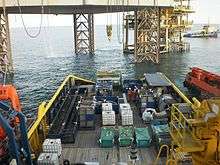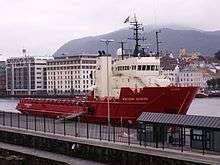Platform supply vessel
A Platform supply vessel (often abbreviated as PSV) is a ship specially designed to supply offshore oil and gas platforms.[1] These ships range from 50 to 100 meters in length and accomplish a variety of tasks. The primary function for most of these vessels is logistic support and transportation of goods, tools, equipment and personnel to and from offshore oil platforms and other offshore structures. In the recent years a new generation of Platform Supply Vessel entered the market, usually equipped with Class 1 or Class 2 Dynamic Positioning System.
Capabilities
Cargo

A primary function of a platform supply vessel is to transport supplies to the oil platform and return other cargoes to shore. Cargo tanks for drilling mud, pulverized cement, diesel fuel, potable and non-potable water, and chemicals used in the drilling process comprise the bulk of the cargo spaces. Fuel, water, and chemicals are almost always required by oil platforms. Certain other chemicals must be returned to shore for proper recycling or disposal, however, crude oil product from the rig is usually not a supply vessel cargo.
Support
Common and specialty tools are carried on the large decks of these vessels. Most carry a combination of deck cargoes and bulk cargo in tanks below deck. Many ships are constructed (or re-fitted) to accomplish a particular job. Some of these vessels are equipped with a firefighting capability and fire monitors for fighting platform fires. Some vessels are equipped with oil containment and recovery equipment to assist in the cleanup of a spill at sea. Other vessels are equipped with tools, chemicals and personnel to "work-over" existing oil wells for the purpose of increasing the wells' production.
Vessel crews

Crew on these ships can number up to 36 crew members, depending on the size, working area and whether DP equipped or not.
Daily operations
Crews sign on to work and live aboard the ship an extended period of time (4 – 6 weeks). This is followed by similar period of time off, often depending on the ship owner / operator the number of weeks or months aboard, specially this period the Companies due to lack of Offshore projects could ask to remain on board 3 months, and after this trip 1 month off. Work details on platform supply vessels, like many ships, are organized into shifts of up to 12 hours.
Living aboard the ship, each crew member and worker will have at least 12 hour shift, lasting some portion of a 24-hour day. Supply vessels are provided with a "bridge" area for navigating and operating the ship, machinery spaces, living quarters, and galley and mess room. Some have built in work areas, and common areas for entertainment. The large main deck area is sometimes utilized for portable housing.
Living quarters consist of cabins, lockers, offices and spaces for storing personal items. Living areas are provided with wash basins, showers and toilets. Officers living quarters are sometimes outfitted with a small work desk, private sinks, showers and toilets. Satellite TV and Wi-Fi is also common with new generation of vessels in high-standard ship owners.
The "galley" or cooking and eating areas aboard ship will be stocked with enough grocery items to last for the intended voyage but with ability also to store provision for months if required. A walk-in size cooler and freezer, a commercial stove and oven, deep sinks, storage and counter space will be available for the persons doing the cooking. The eating area will have coffee makers, toasters, microwave ovens, cafeteria style seating, and other amenities needed to feed a hard working crew.
See also
- Anchor handling tug supply vessel
- Ebb Tide - the first PSV of modern style
References
- ↑ "Platform Supply Vessels". EMAS (company). Retrieved 27 December 2015.